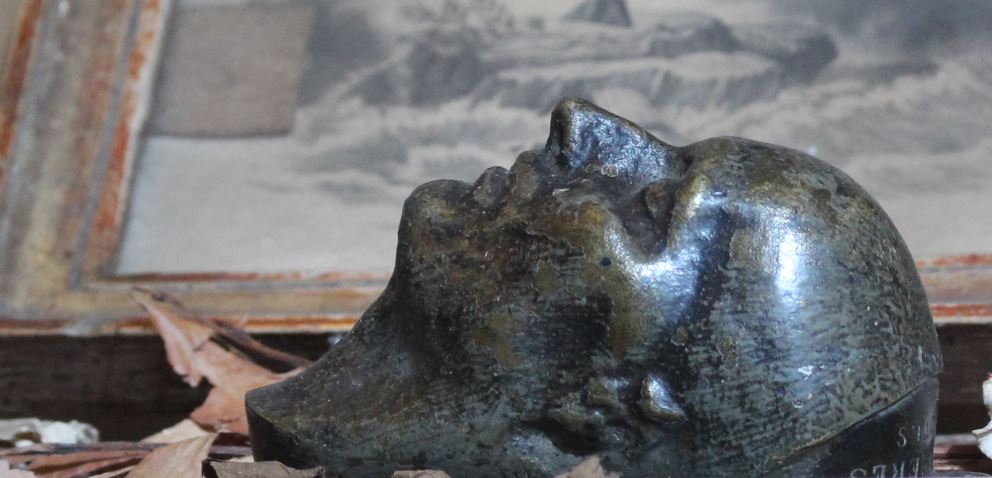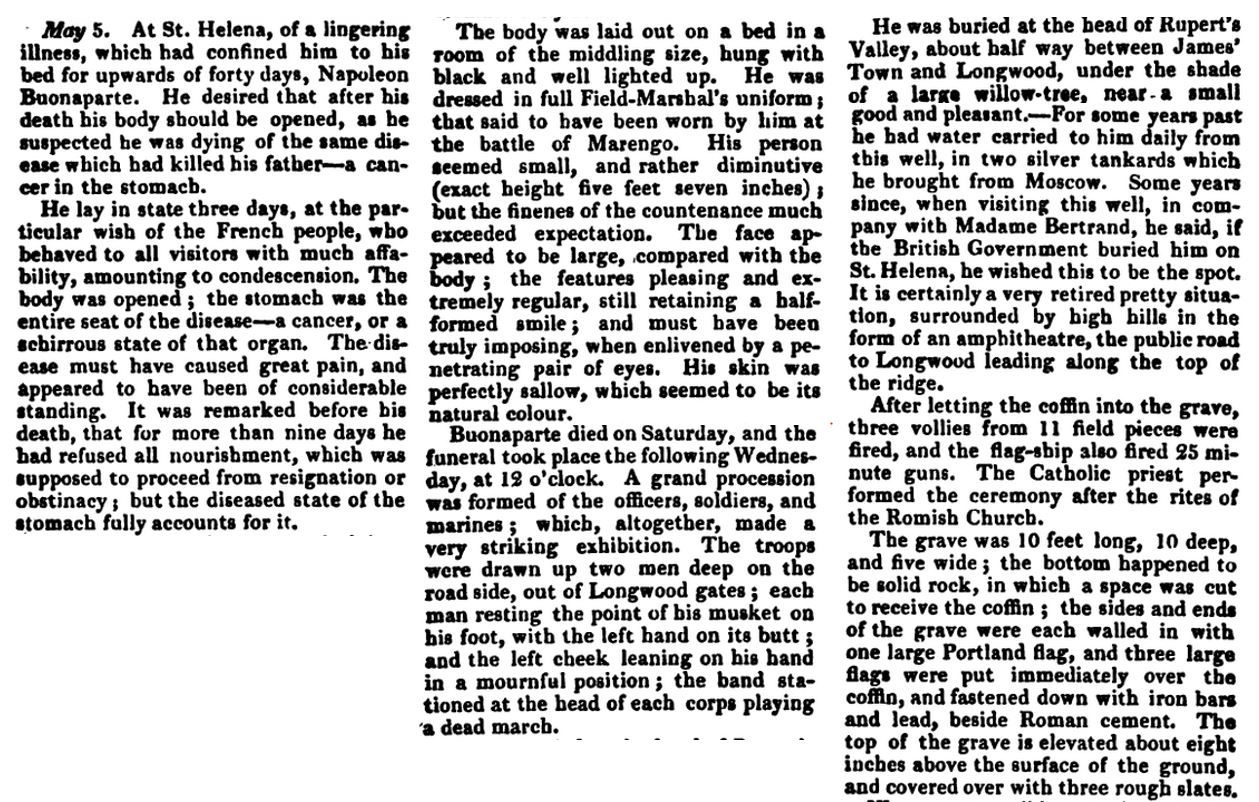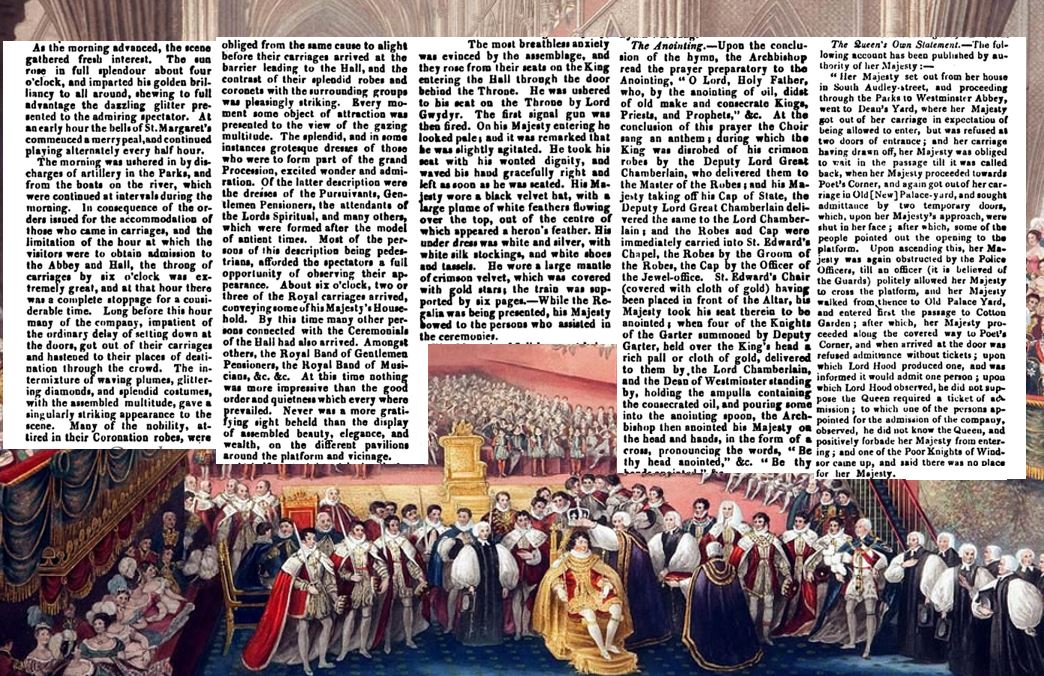 The death of Britain’s archenemy, an extravagant Coronation, and the building of the very first electric motor are among the events of a year still marked by the economic depression after the Napoleonic Wars.
The death of Britain’s archenemy, an extravagant Coronation, and the building of the very first electric motor are among the events of a year still marked by the economic depression after the Napoleonic Wars.
With George IV. ascending the throne, the Regency period comes to an end. The world has changed a lot since he ruled the country as Prince Regent from 1811, and even more since the period’s key-persons were born.
Which political, scientific, social, and literary events and anniversaries are of interest to Regency Enthusiasts in 2021? Have a look at my list of 21 events of 1821 here:
2. February: ‘Cinderloo’ uprising over a pay cut in the Coalbrookdale Coalfield ended with two persons killed, and several arrests.
After the Napoleonic Wars a period of economic depression had begun. The Coalbrookdale Coalfields, a leading coal-mining area, experienced a phase of industrial stagnation and competition from other British iron works and coal production industries. Local ironmasters decided to reduce the pay of their workers by 6d per day. In response the workers went on strike. Their actions included halting the production, blowing out furnaces, and damaging machinery.
The magistrates called out the local yeomanry. 3,000 workers retreated to Cinder Hills near Dawley and threatened violence. The Riot Act was read. The strikers refused to dissipate, and hurled rocks and cinders at the troops. The Yeomanry forwarded to arrest the ringleaders, and it came under continued assault from the crowd. In the following tumult, the command for the Yeomanry to open fire on the crowd was given. Two workers were killed. Of the nine persons arrested, seven were sentenced to nine months hard labour. The two ringleaders were sentenced to death by hanging, one of them managed to secure a reprieve later.
The initial dispute which had caused the riot was resolved soon after, with some ironmasters agreeing to reduce the daily pay of the workers by 4d instead of 6d. (read more: https://cinderloo.com/)

18. February: First edition of the newspaper New Observer
The newspaper changed its name to Independent Observer in April 1821. There was no connection to the Observer, which had been founded in 1791. The Independent Observer became today’s The Sunday Times.
23. February: Death of John Keats
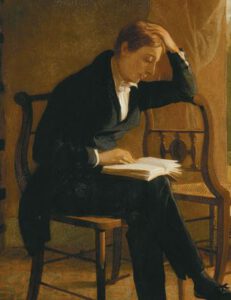 John Keats, one of the leading writers of the second generation of Romantic poets, died of tuberculosis in Rome, aged only 25. He was buried in Rome’s Protestant Cemetery. Keats’s last request was that his tombstone would bear no name or date, only the words, “Here lies One whose Name was writ in Water.”
John Keats, one of the leading writers of the second generation of Romantic poets, died of tuberculosis in Rome, aged only 25. He was buried in Rome’s Protestant Cemetery. Keats’s last request was that his tombstone would bear no name or date, only the words, “Here lies One whose Name was writ in Water.”
27. February: Happy 50th birthday to Jane Addison
Jane Addison (1771 –1851) was the first woman in Britain to petition a divorce (with the ability to remarry) against her husband through an Act of Parliament. The divorce was on the grounds of her husband’s adultery with Jane’s sister. It was granted in 1801. The Jane Addison case was publicly declared by officials as an exception. Divorce became easier to acquire after 1857. Prior to 1857, there were only 329 successful divorces granted in Britain, and only four other women successfully won full divorce petitions against their husbands.
Mary Anning found a skeleton of the species Ichthyosaurus platydon at Lyme Regis
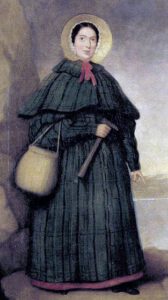 In the winter of 1820/21, fossil collector, dealer, and palaeontologist Mary Anning found the 6.1 m skeleton from which the species Ichthyosaurus platydon (today: Temnodontosaurus platyodon) would be named. Mary found the first ichthyosaur skeleton in 1811, and between 1815 and 1819 she found several other ichthyosaur fossils, including almost complete skeletons of varying sizes.
In the winter of 1820/21, fossil collector, dealer, and palaeontologist Mary Anning found the 6.1 m skeleton from which the species Ichthyosaurus platydon (today: Temnodontosaurus platyodon) would be named. Mary found the first ichthyosaur skeleton in 1811, and between 1815 and 1819 she found several other ichthyosaur fossils, including almost complete skeletons of varying sizes.
As a woman, Mary was as an outsider to the scientific community. Although she knew more about fossils and geology than many of the wealthy fossilists to whom she sold her finds, it was always the male geologists who published the scientific descriptions of the specimens she found, and they often neglected to mention Mary’s name.
23. March: Happy 50th birthday to Sir Lumley St George Skeffington
 Sir Lumley St George Skeffington, 2nd Baronet, was a noted dandy. The Prince Regent consulted him on dress and style. Skeffington also invented the colour Skeffington brown, which is said to be an olive green-tinged brown. Besides his duties as nobleman and dandy, he was a playwright. He wrote and produced his own plays, his greatest success being “The Sleeping Beauty” at Drury Lane in 1805. He loved fashion and the theatre. His peculiarities exposed him to the satire of Gillray’s charicatures.
Sir Lumley St George Skeffington, 2nd Baronet, was a noted dandy. The Prince Regent consulted him on dress and style. Skeffington also invented the colour Skeffington brown, which is said to be an olive green-tinged brown. Besides his duties as nobleman and dandy, he was a playwright. He wrote and produced his own plays, his greatest success being “The Sleeping Beauty” at Drury Lane in 1805. He loved fashion and the theatre. His peculiarities exposed him to the satire of Gillray’s charicatures.
13. April: Happy 50th birthday to Richard Trevithick
 Richard Trevithick was an inventor and early pioneer of steam-powered road and rail transport. He developed the first high-pressure steam engine and built the first working railway steam locomotive. He became famous for the locomotive called “Catch Me Who Can” that was a major London attraction in 1808. Richard celebrated his 50th birthday in Peru, where he worked on draining silver mines.
Richard Trevithick was an inventor and early pioneer of steam-powered road and rail transport. He developed the first high-pressure steam engine and built the first working railway steam locomotive. He became famous for the locomotive called “Catch Me Who Can” that was a major London attraction in 1808. Richard celebrated his 50th birthday in Peru, where he worked on draining silver mines.
Click here to watch a video of a replica of the Puffing Devil run in today’s Camborne: https://www.youtube.com/watch?v=FEjGBgBxSNM (Video by Cornishpastyman, 29 April 2017)
5. May: First edition of the newspaper Manchester Guardian.
The newspaper was founded by cotton merchant John Edward Taylor. It became today’s The Guardian.
5. May: Napoleon Bonaparte died in exile on the island of St. Helena.
In February 1821, Napoleon’s health began to deteriorate. He suffered from abdominal pain, nausea, night sweats, fever, constipation and diarrhoea. His speech became slurred. He died on 5 May after confession. His last words are unclear, they might have been, “tête d’armée”, or “France, l’armée, tête d’armée, Joséphine”. Several versions exist in different reports. In his will, Napoleons had asked to be buried on the banks of the Seine, but the British governor decided he should be buried on Saint Helena.
The news of Napoleon’s death reached Britain on July 4. Read more about worldwide newspaper comments here: https://shannonselin.com/2016/05/napoleons-death-reported/
Napoleon’s death was premature, and the cause unclear. Diagnoses included stomach cancer, and murder by poisoning. While it seems possible that Napoleon died of arsenic poisoning, there is (yet) no proof that someone murdered him with arsenic. The poison was omnipresent in a 19th century household: cosmetics, hair tonic, cigarettes, sealing wax, cooking pots, insect-repellent powders, etc contained arsenic, and Napoleon could have absorbed too much of it by himself.
7. May: The Bank of England returns to the gold standard
The Act for the Resumption of Cash Payments (1819) had set 1823 as the date for the resumption of convertibility. It was reached by 1821. The weight of the new gold sovereigns was calculated on the basis that the value of one troy pound of standard (22 carat) gold was £46 14s 6d. Sovereigns therefore in theory weighed 123.2744783 grains or 7.988030269 grams.
Background: In the 1790s, the United Kingdom suffered a silver shortage. In an attempt by the British government to re-stabilise the currency of Britain, the Bank of England began a massive recoinage programme in 1816 that created standard gold sovereigns, circulating crowns, half-crowns and eventually copper farthings in 1821. Nearly 40 million shillings were struck between 1816 and 1820, 17 million half crowns and 1.3 million silver crowns.
30. May: Happy 50th birthday to Jeanne Louise Antonini
Jeanne Louise Antonini (1771 –1861) disguised herself as a male to join the French Navy during the Napoleonic Wars. She was able to conceal her true identity. After 10 years, she was captured and wounded during an action with the British Navy after the frigate she served on had left the port of Santo Domingo. As a prisoner, she was interned on a pontoon off the coast of Plymouth / England for eighteen months. Following the signing of a treaty between the British and French, she was allowed to return to France. There, she joined the French Army, still disguised as a male. Over the next 15 years, she was able to rise in rank to corporal and to sergeant.
8. June: Happy 50th birthday to Henry Thomas Austen
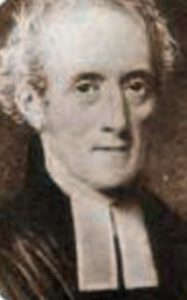 By 1821, Henry Thomas Austen (1771 –1850), favourite brother of Jane Austen, has led a versatile life, working as a militia officer, banker, and clergyman. In 1816, his bank collapsed, and Henry decided to enter the church. He was appointed curate of Chawton. In 1819, he was appointed curate at Farnham / Surrey, and he also worked as a master at the Farnham Grammar School. Henry helped Jane with proofreading, editing and the publishing process.
By 1821, Henry Thomas Austen (1771 –1850), favourite brother of Jane Austen, has led a versatile life, working as a militia officer, banker, and clergyman. In 1816, his bank collapsed, and Henry decided to enter the church. He was appointed curate of Chawton. In 1819, he was appointed curate at Farnham / Surrey, and he also worked as a master at the Farnham Grammar School. Henry helped Jane with proofreading, editing and the publishing process.
19. July: George IV crowned king of the United Kingdom of Great Britain and Ireland at Westminster Abbey.
The coronation was an immensely extravagant event. The total cost of the coronation was £238,000, more than twenty times the cost of the previous event in 1761.
Dress code and royal attire: The King insisted that the participants should dress in Tudor and Stuart period costumes. £44,939 were spend on uniforms, robes and costumes. Invited guests had to pay for their own attire. George IV’s personal coronation outfit, including a red velvet robe of 8.2 m, cost more than £24,000. Over £50,000 were spent on the new Coronation Crown. A crown-like hatband for a plumed hat was designed for £8,000.
The Coronation feast: £25,184 were spent on the coronation banquet. 160 tureens of soup and 160 dishes each of hot fish, vegetables, roast dishes, 480 sauce boats, along with 3,271 cold dishes were prepared.
Events for the public: public celebrations in London included the ascent of a gas balloon from Green Park, a boat race, and the illumination of the trees and The Serpentine with lanterns at Hyde Park, and a firework display.
7. August: Death of Caroline of Brunswick, Queen of the United Kingdom and Hanover as the wife of King George IV.
In July, Caroline was barred from the coronation on the orders of George IV. She fell ill and died three weeks later. Her physicians believed she died of an intestinal obstruction. At the time there were rumours that she had been poisoned. Caroline was buried in her native city Brunswick.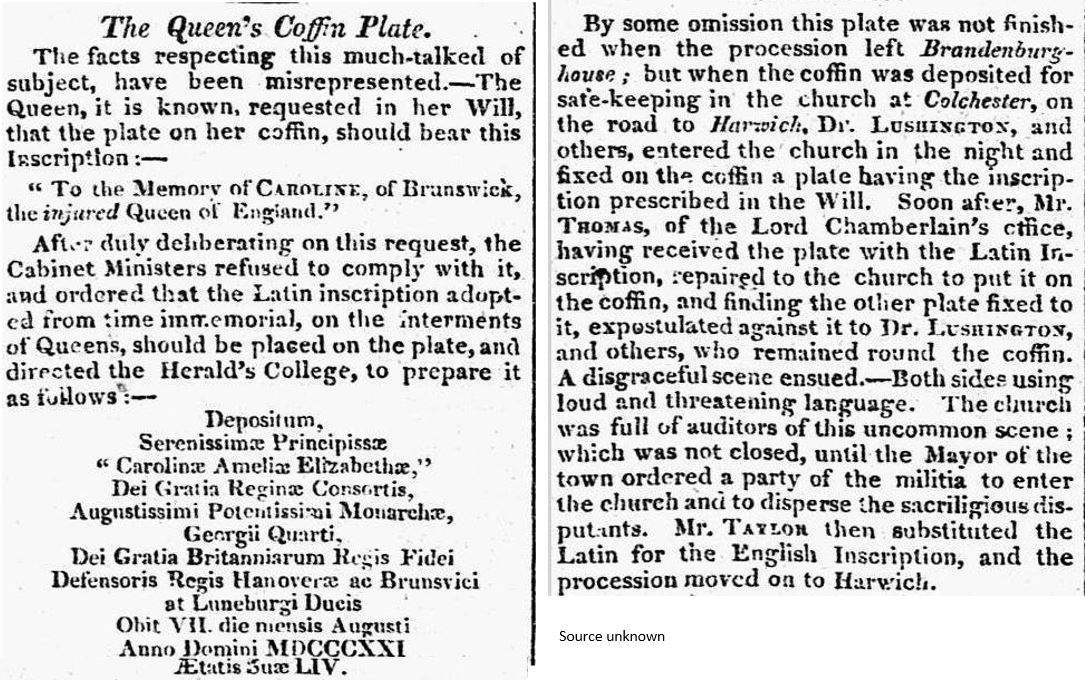
15. August; Happy 50th birthday to Sir Walter Scott
 The famous Scottish historical novelist and historian, author of – so far – 11 novels and many poems and songs, was doing well by 1821:
The famous Scottish historical novelist and historian, author of – so far – 11 novels and many poems and songs, was doing well by 1821:
In the previous 5 years, he conducted a search for the Crown Jewels (“Honours of Scotland“) that had been hidden away in Cromwell’s time. The jewels were found in 1818. He had been made a baronet in 1820. He had served as the President of the Royal Society of Edinburgh since 1820. In August 1821, he was still to learn that he would soon be asked by the city council of Edinburgh, and at the sovereign’s behest, to stage-manage the 1822 visit of King George IV to Scotland.
22. August: Happy 50th birthday to Henry Maudslay
Henry Maudslay was a machine tool innovator and the inventor of the metal lathe. He is considered a founding father of machine tool technology. His inventions were an important foundation for the Industrial Revolution. Henry was an early member of the Institution of Civil Engineers (founded in 1818).
September: Very first electric motor built
 Michael Faraday build two devices to produce what he called “electromagnetic rotation” These experiments and inventions formed the foundation of modern electromagnetic technology.
Michael Faraday build two devices to produce what he called “electromagnetic rotation” These experiments and inventions formed the foundation of modern electromagnetic technology.
4. October: Death of John Rennie the Elder
John Rennie the Elder was a civil engineer who designed and built numerous canals, docks and bridges, among them Waterloo Bridge in London. He was a technical innovator and a pioneer in the use of structural cast-iron.
6. December: The South Orkney Islands are discovered
The South Orkney Islands (604 kilometers north-east of the tip of the Antarctic Peninsula) were discovered by the American Nathaniel Brown Palmer and the British George Powell. The Islands were originally named Powell’s Group, with the main island named Coronation Island as it was the year of the coronation of King George IV.
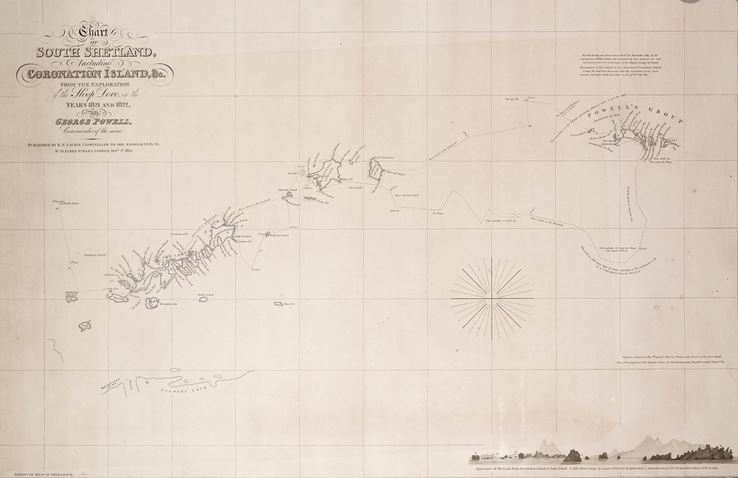
Chart of South Shetland including Coronation Island, &c. from the exploration of the sloop Dove in the years 1821 and 1822 by George Powell Commander of the same. Powell, George, 1822 © National Maritime Museum Collections
12. December: Death of Phoebe Hessel, female soldier
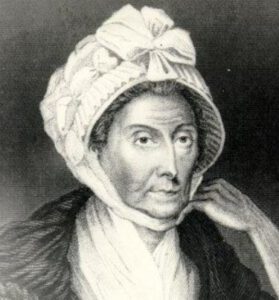 Phoebe disguised herself as a man to serve in the British Army. She served as a soldier in the West Indies, Gibraltar, and the Battle of Fontenoy in 1745. Phoebe lived to the age of 108.
Phoebe disguised herself as a man to serve in the British Army. She served as a soldier in the West Indies, Gibraltar, and the Battle of Fontenoy in 1745. Phoebe lived to the age of 108.
Happy 50th birthday to Agnes Reston
Agnes Reston (1771 –1856), a Scottish sergeant’s wife, displayed outstanding bravery in an early phase of the Siege of Cádiz of the Peninsular War. When the fort at Matagorda, near Cadiz, was bombarded by French forces, she assisted the surgeon in dressing the fast-increasing numbers of wounded me. In between her nursing duties, she carried sand bags for repair of the battery, handed along ammunition, and supplied the gunners with wine and water. She refused to leave when the other women in the battery were removed to safety, and remained with the men in the dilapidated fort with little ammunition, until the following day brought the withdrawal of the French forces. She has become known as the Heroine of Matagord for her bravery.
Related articles
Article by Anna M. Thane, author of the novel
“Von tadellosem Ruf” (http://amzn.to/2TXvrez)


